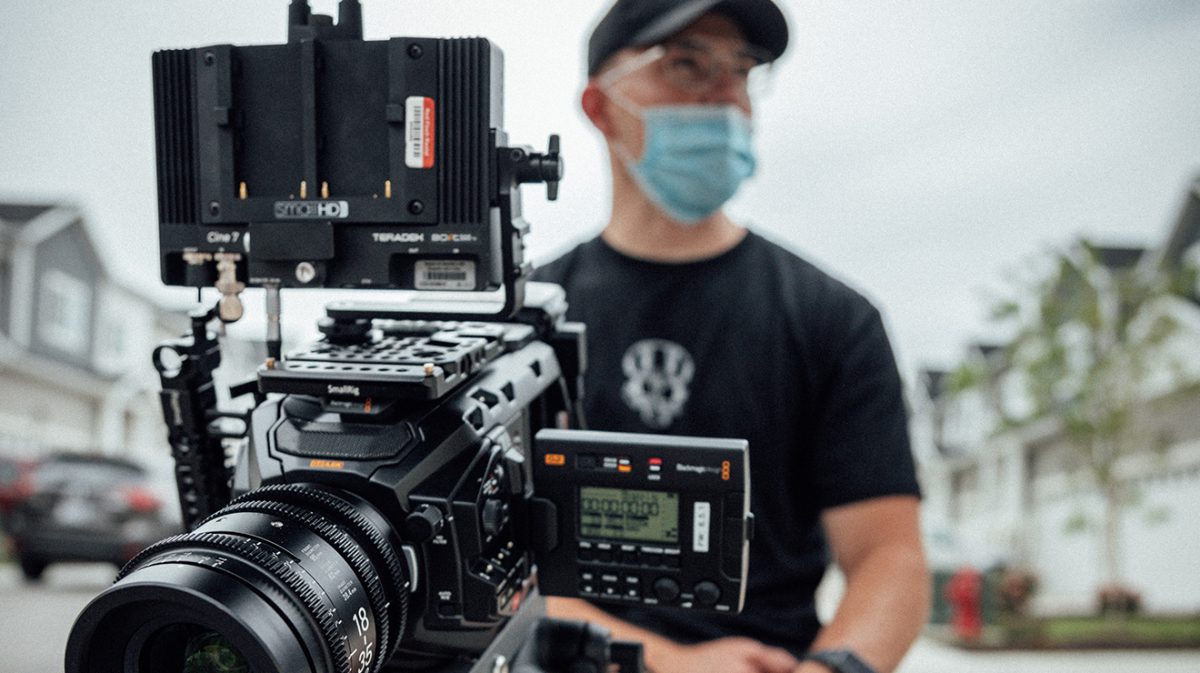Is it possible to run a shoot safely in a pandemic? It’s been several months since the world came to a screeching halt, and many of us are eager to get behind or in front of a camera again.
However, the stakes are clearly high. For cast and crew, and anyone close to them, a serious illness could be a matter of life or death.
In this post, we’re looking at how major production studios have adapted to the new normal through emerging best practices to help everyone stay safe.
Pandemic Problems
Filming in a pandemic comes with a host of challenges. Most videos featuring actors require them to interact without face coverings, and in close proximity to each other. Under normal circumstances, that’s hardly an issue. But when you’re trying to prevent the spread of an airborne disease, it’s clearly problematic.
Of course, it’s not just your on-camera talent you have to worry about. A typical film shoot is a busy, bustling place. There are usually more people behind the camera than in front of it.
Sadly, there have been reports of both cast and crew members becoming ill, and there has been at least one death associated with a production. Clearly, it is paramount to take safety precautions and to prioritize the health and wellbeing of cast and crew above all else.
If you’re considering whether to produce a video in the near future, the most important thing to keep in mind is that the safest option is to figure out a way to produce it without bringing everyone on set. Constraints can fuel creativity if you start seeing them as an opportunity rather than a negative block. For instance, SNL found a creative way to manage production remotely, and an entertaining horror film about a Zoom seance went viral.
So, what can we learn from these different approaches? Mainly that COVID will impact all aspects of your productions, from the concept and location, to the production and, of course, the cast and crew.
Concept
With a few exceptions, plots involving lots of combat scenes or intimacy, or almost anything requiring people to perform lines face to face are being scrapped. Instead, we’re seeing imaginative ideas that focus much more on individual experiences, or limited casts with far fewer extras.
For example, Tilda Swinton stars in an upcoming short that focuses on the isolating experience of waiting for someone to reach out. The Human Voice is remarkable for how transportive and very “right now” the plot feels. Content that can tap into our collective experience will resonate and connect with audiences.
Location
A lot depends on the specific location where your shoot is taking place. Regulations vary tremendously, as do the chances of catching a serious illness.
Many major productions have shifted from the US to overseas locations with much lower rates of illness. A change in location does not come at a low cost, and there are significant logistical challenges to doing so. Moreover, travel is still restricted in many areas, so extra steps and paperwork are often required for a drastic move such as this.
A less drastic option would be to move your production outdoors, to an area within your home country with lower rates of infections, or to choose a location that makes it easier to control access to the set. Some studios have already upgraded their ventilation systems to help prevent the spread of disease, and others are adding more controls and policies over how the set can be accessed, and by whom.
For instance, Pinewood Studios in Atlanta is monitoring the health and safety of workers by implementing weekly COVID tests, using an app to track symptoms between tests, and badges linked to testing results are required for accessing different areas of the studio.
Cast and Crew
The health and safety of those working on your production is everything. While there are specific guidelines in place in many areas, the situation is continuing to evolve.
The safest option is to abide by the stricter set of regulations that applies to your production. If there aren’t any local regulations you can refer to, or if they feel inadequate, the “Safe Way Forward” guidelines, published in a joint effort by multiple unions, is an excellent reference. It builds on the reopening white paper from the Alliance of Motion Picture and Television Producers published in June.
New Roles
So far, there are two big ways small-scale productions have changed. The first is that there is a medic present on set, even for a small, five-person shoot. And, one person is now designated to be in charge of COVID precautions. For it to be done well, you can’t just pile these extra responsibilities onto an already-stressed producer.
This role entails: enforcing mask wearing and distancing requirements, and making sure materials like sanitizer and PPE are readily available. They’re also in charge of a meeting at the beginning of the shoot to inform everyone of the rules. And, most productions now include COVID protocols in the call sheet beforehand, as well, so everyone knows what to expect.
More Participants in Pre-Production
Another shift that’s occurring is to involve more of the team in the pre-production planning than before. By doing so, you can provide reassurance that their concerns are being met, and answer any questions they may have. Of course, this is being done remotely via video chat or phone.
Minimizing In-Person Contact
Yet another change we’ve seen is to make every effort to minimize person-to-person contact as much as possible. For instance, many productions are enabling actors to handle more of their setup than before. It could be as simple as coaching them on mic placement so they can do it themselves, or applying their own makeup.
Larger shoots are also implementing the recommended “Zone” approach to avoiding unnecessary contact between different team members. The basic concept is to divide the team into different zones according to the type of work they are doing on the production. Then, restrict or alternate access to the set accordingly to reduce overlap between the different zones.
Depending on the nature of the work being done, different safety protocols might apply to different zones. For instance, set builders and designers typically do not need to interact with the cast, and can often perform their work while wearing PPE. Meanwhile, cast members need to interact with the director and producers, and are unlikely to be able to wear PPE at all times. Therefore, members of that zone will likely require stricter testing protocols than those able to wear protective gear. By carefully defining zones for your production, and devising the appropriate protocols for each zone, you can reduce confusion on set.
Lessons From a Major Production
When it comes to managing the safety of your team, there are lessons to be learned from one of the largest productions to be green-lighted since the pandemic broke out. Filming paused on Jurassic World: Dominion earlier this year, but recently resumed over the summer.
The level of collaboration and coordination required to restart production was nothing short of herculean. Here are some of the key changes that allowed production to restart.
Location
This installment in the Jurassic Park franchise benefitted from its original filming location in England. Because it was already planned and underway, it required fewer approvals and logistical headaches to get the go-ahead.
Accommodations
First, the production team booked an entire hotel to house the cast and crew for the duration of the shoot in England. Prior to the pandemic, this was not a usual practice, even for large productions.
The cast and crew received COVID tests upon arrival, and were asked to stay quarantined for an initial two-week period. Only then were they able to move about the hotel and socialize.
Pandemic Procedures
A 107-page safety manual stipulated how all other aspects of production would be handled from a health and safety standpoint. Everything, from temperature scans and weekly testing, to serving meals on set was covered in detail.
Production Zones
One important change was to divide the cast and crew into different teams according to their role in the production and how vital they were to its completion. In an interview for the NY Times, one of the stars compared it to a closed set. The director, cast, and essential crew comprised a “Green Zone” with stringent testing protocols. Anyone working on pre-production, like sets or props, had more limited access to the set.
Costs
Of course, these changes were not easy, or cheap. Operating a large, 750 person production required medical staff on set, around 18,000 COVID tests, and 150 hand sanitizer stations, plus hand-washing sinks and temperature scanners.
The cost for all the safety enhancements was estimated at around $9 million. Based on data from other productions, COVID precautions can increase your budget by 25% or more.
Outcome
While every precaution was taken, filming was halted after four crew members tested positive for COVID-19 in August and had to self-isolate. While no one became seriously ill, it shows how difficult it is to maintain a quarantine bubble on set.
Production was able to resume, but adjustments were made to the scale of production in different locations. For instance, a spike in cases in Malta led to a significant reduction in anticipated team size. The stop-start-stop nature of production, along with the evolving situation, make video production a truly difficult feat in these circumstances.
Going Forward
If you decide to move forward with a production, you really have to think through how to do so as safely as possible. And, if you can devise a concept that obviates the need to bring everyone together, you should explore it.
There are still many unanswered questions, as this is truly uncharted territory. Ultimately, we expect the video industry to get back to work slowly, with many adjustments along the way.
Are you planning to produce a video any time soon? What sort of precautions are you taking? Share your tips in the comments below.






